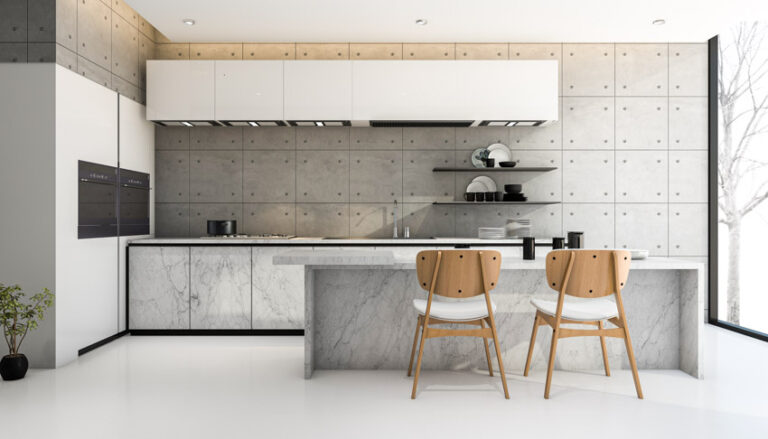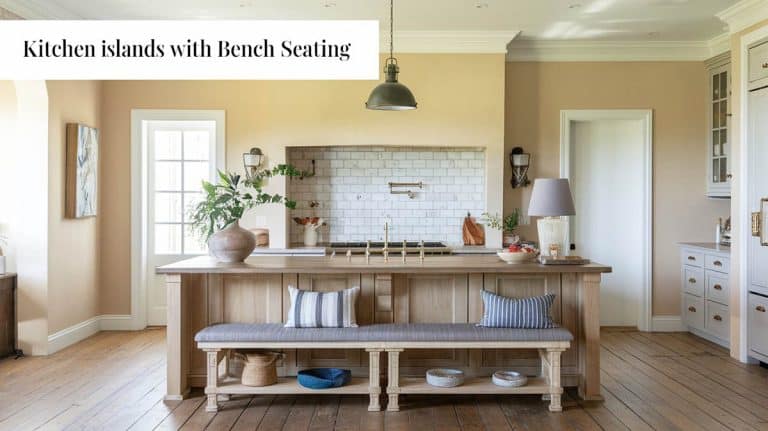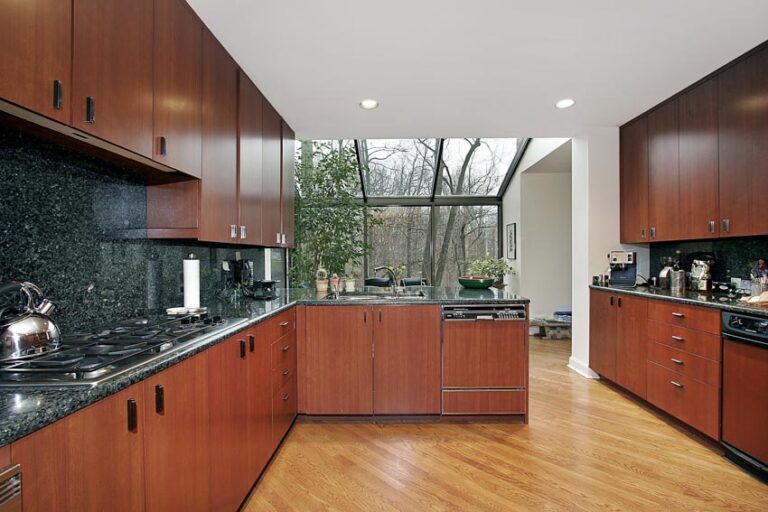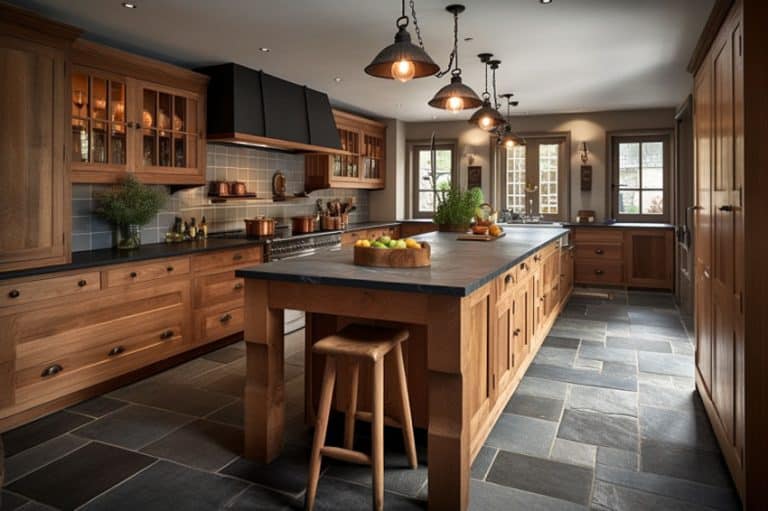Should You Consider Laminate Kitchen Cabinets? Types & Designs
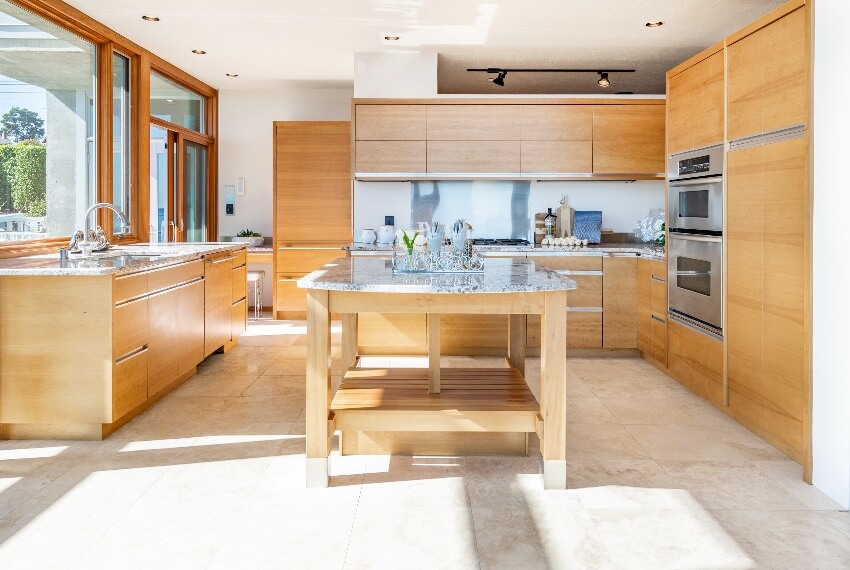
If you are planning to renovate your cooking space, purchasing new cabinets could be a significant and expensive option. Flat-panel doors and Euro-style cabinets are becoming increasingly fashionable nowadays, but luckily there are some more practical and intriguing options for homeowners trying to save funds on a full remodel.
Instead of changing the kitchen cabinets entirely, homeowners are seeking alternatives that allow them to overlay their current cabinets and doors with a synthetic finish. Laminate is an excellent cabinet covering material that can be applied to the surface of wood or panels to help transform their look. Kitchen cabinets can occupy more than 30% of the standard kitchen remodeling cost. If you desire to cut some renovation costs, you may want to consider using laminate kitchen cabinets.
What Are Laminate Cabinets?
The laminate surface that is used to cover kitchen cabinets is technically a synthetic material that is usually made out of compacted wooden fiberboard. Depending on the grade of laminate employed, the laminate covering might vary greatly.
In general, it is a surface component that is formed by compressing paper and resin firmly under pressure and heat. Laminate is available in both high-pressure and low-pressure versions. The highest grade of the two is high-pressure laminate.
Low-pressure laminate, like melamine, is normally applied on lower-cost kitchen cabinetry but is less resilient than high-pressure laminate. It is also available in limited colors, making it less desirable to homeowners who want a broad range of color selections.
A high-pressure laminate, on the other hand, that is produced under 1400 PSI, will provide a higher-quality and longer-lasting product that will not chip and break as easily as a low-pressure laminate. However, they are quite more costly than the low-pressure ones.
The Benefits Of Laminate Cabinets
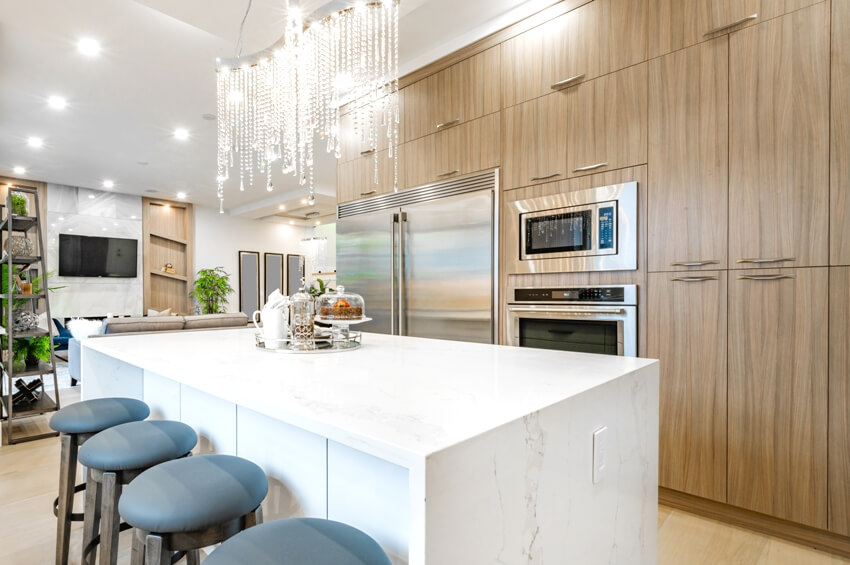
Aside from its inexpensive cost, one of the key benefits of utilizing laminate is that it is a robust material that will withstand the intensive activity of the normal kitchen. It does not deform over time, as hardwood does, and it is impervious to discoloration.
Furthermore, laminate keeps staining color equally, hence every cabinet in your kitchen will be precisely identical. Laminate, particularly the high-pressure variant, is also obtainable in a broad range of colors, patterns, and door types.
This allows laminate cabinets to be utilized in both conventional and modernized kitchens, depending on your personal style and preferences.
When it pertains to laminate cabinets, you will undoubtedly have a variety of styles to select from. Laminate is highly matched with modern or contemporary kitchen layouts overall. Nevertheless, types that resemble classic and ancient cabinet designs are also offered.
Laminate cabinets might be a terrific option for your kitchen cabinet if you are searching for a versatile, sturdy, and low-cost substitute to wood cabinets, especially if you are eyeing a minimalist or modern aesthetic appearance for your kitchen.
Types Of Laminate Kitchen Cabinets
Here’s the most popular styles of laminate materials and finishes.
Matte Laminate

A laminate with a matte finish provides a moderate amount of reflectivity and a uniform, classic finish. Matte-finish laminates give a kitchen a sense of practicality and subtle grandeur.
The most significant feature of matte laminates is their increased resistance to scratches and dirt, making them very easy to wipe and maintain. Matte-texture laminates do not reveal dirt or stains. They are ideal for high-traffic zones such as kitchen cabinets.
Glossy Laminate

A glossy laminate treatment delivers a nice mirror-like luster to it. Due to its capability to reflect light, it brings a sophisticated aesthetic to the kitchen cabinets and enhances brightness to the whole space.
Gloss-finish laminates are wonderful for compact kitchens since they make the space appear bigger than it is. Unfortunately, they are vulnerable to scratches, and they require more frequent cleaning and maintenance because they reveal markings and smudges easily.
Textured Laminate
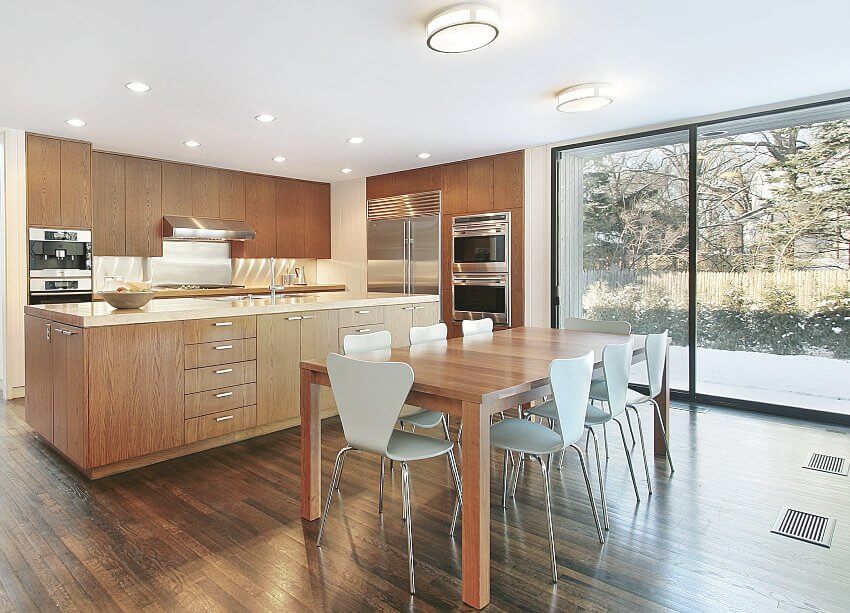
Textured laminate is a simple way to add a touch of complexity to a minimalistic kitchen. Textures that mimic the impression and characteristics of materials such as solid wood are best suited for kitchen cabinets, providing depth to the overall aesthetic.
A heavily textured surface is extremely scratch-resistant. Nonetheless, one drawback of employing texture laminates is that deeply textured laminates can easily retain dirt and grease, making cleaning and maintenance challenges.
Multi-Colored Laminate
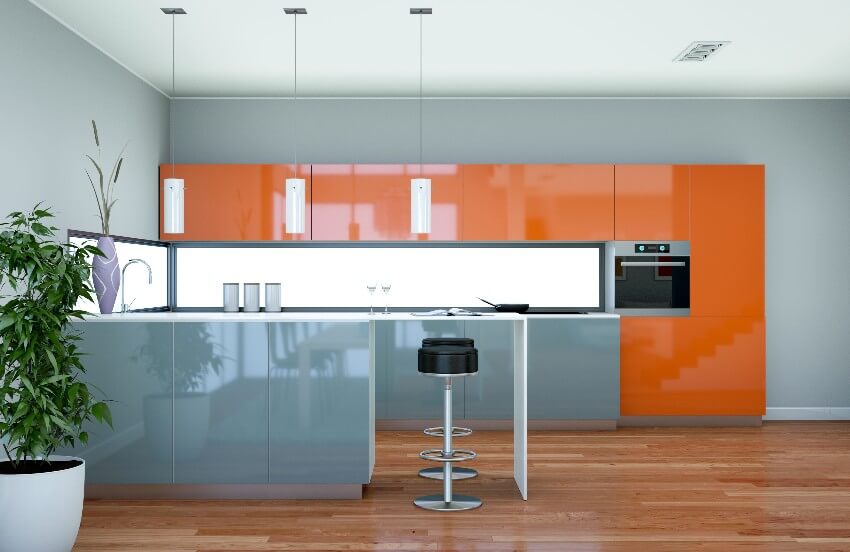
Multi-colored laminates can be used to bring brightness and sparkle to the kitchen space. You can execute it by merging two or three varying colors on your kitchen cabinets.
Pick colors that complement each other very well — maybe a bolder color like hot yellow for a pop of color as well as white to maintain the area feeling spacious and vibrant. Adding gray accents is also clever: they contribute depth to the overall design.
Fire-Resistant Laminate
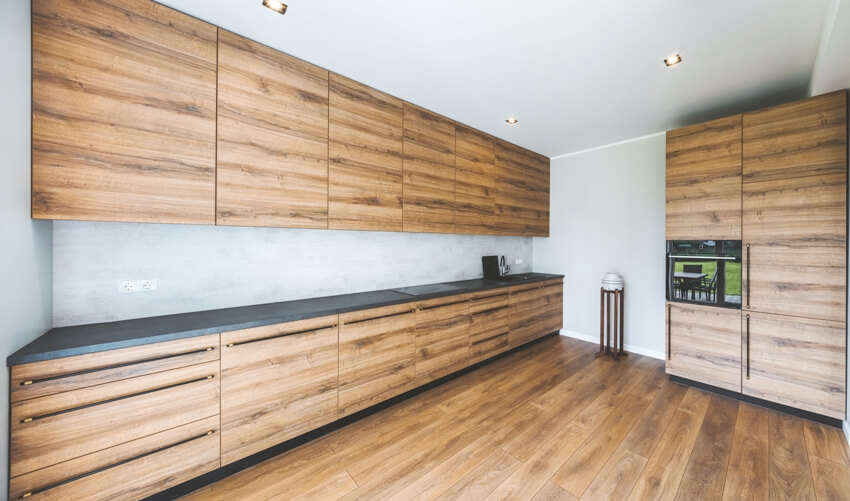
You can consider adding fire-resistant laminates to your kitchen cabinets to increase safety in your kitchen. Because they are coated with specialized chemicals, these laminates can reduce smoke releases in the event of a fire. They do not emit hazardous smoke, and the temperature increase of the laminate is delayed.
Metallic Laminate
You can take into account adding a laminate with a metallic finish for a streamlined, futuristic design in your cabinets. The luster of metal laminates adds a uniqueness to it that readily adds a premium aesthetic to your kitchen.
These are more costly than standard laminate finishes and come in limited color selections, such as copper, silver, and rose gold.
Antibacterial Laminate
Antibacterial laminates can help you maintain a high degree of sanitation in your kitchen by inhibiting the development of microorganisms. These are constructed of unique antimicrobial additions that make them resistant to mold, insects, and many bacteria.
As a result, these laminates’ antiseptic and antibacterial capabilities hinder the formation and spread of different microorganisms. This is indeed a great option for your cabinets.
Fingerprint-Resistant Laminate

Fingerprint-, dust-, heat-, and scratch-resistance are all desirable features of fingerprint-resistant laminates. This type of laminate cabinet has a low-reflective surface that does not display grease streaks or marks. It is also simple to maintain since all contaminants on the surface can be easily eliminated.
Acrylic Laminate
Laminates with an acrylic finish will provide your cabinet with a luxurious, modern appeal. These are extremely durable and have a reflecting great gloss finish that comes in a variety of colors. Acrylic finish laminates are water-resistant and very impervious to UV light degradation.
The disadvantages of adopting acrylic finish laminates are that they are quite expensive, susceptible to scratches, and require constant cleaning due to the continual presence of fingerprints.
Laminate Cabinet Colors
Here are some laminated cabinet color ideas.
White Laminate
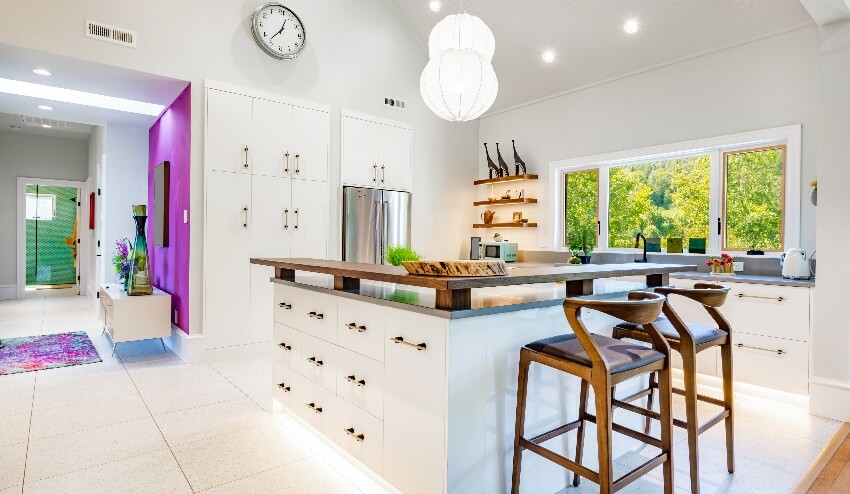
White laminate cabinets match very well with any design, whether it is modern, classic, trendy, or colorful. They can also be used as a subtle backdrop to draw attention to all of your distinctive elements and décor.
Choosing white laminate cabinets can help to simplify the remainder of the decision-making phase. You will not have to worry about which countertops will complement if your wall paint colors will conflict or what kind of equipment to install on your cabinet knobs if you have white laminate cabinets.
White laminate cabinets capture and reflect light, making the culinary space appear more spacious and clean than it is. If your area is on the small side, white laminate can provide the idea of larger space. Truly, this inexpensive process can make your cooking area look larger.
For white cabinets, laminate is arguably the best exterior material to use. White is the most common laminate cabinet color, but it also has the highest likelihood of showing fingerprints.
Indeed, low-maintenance cabinets will always be your best friend. Wooden cabinetry that has been painted white are difficult to clean, and they are prone to warping and other issues.
Gray Laminate
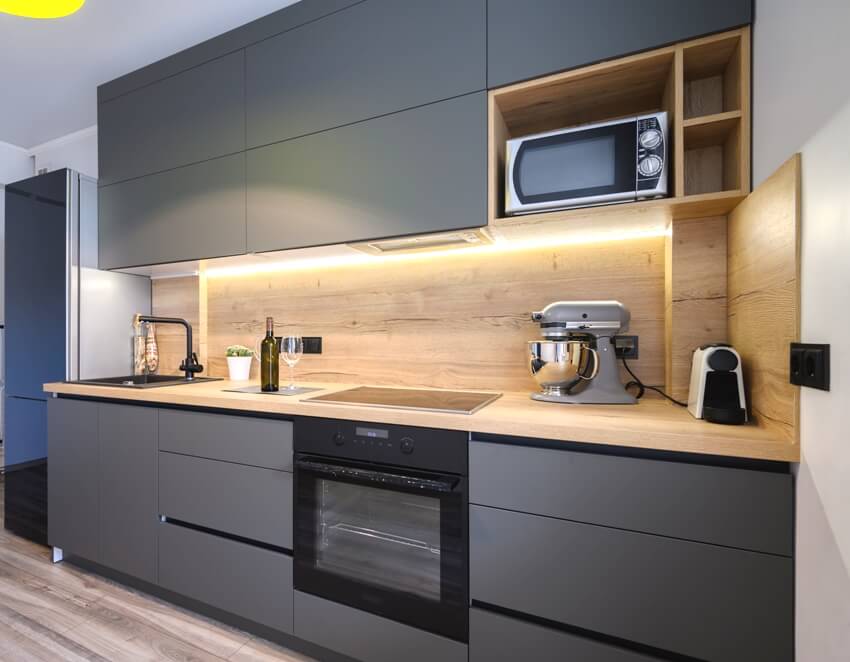
Gray kitchen cabinets look great with laminate. Working with a gray palette can give stylish results. Gray cabinets can give your space a refined look. These cabinets provide a pristine aesthetic while adding beauty to your culinary space. They do not end up making a room appear gloomy.
Gray is a wonderful middle ground between white and black. You may cover the filth in your cooking area or produce a bold statement with gray if you want a unique design trend.
Gray laminate cabinets go well with marble, single-layer, laminate, and hardwood countertops. Whatever your idea for your design, gray laminate cabinetry can be the neutral centerpiece that ties it all together and pairs well with statement decorations, read more about laminate kitchen countertops here.
Laminate Kitchen Cabinet Doors
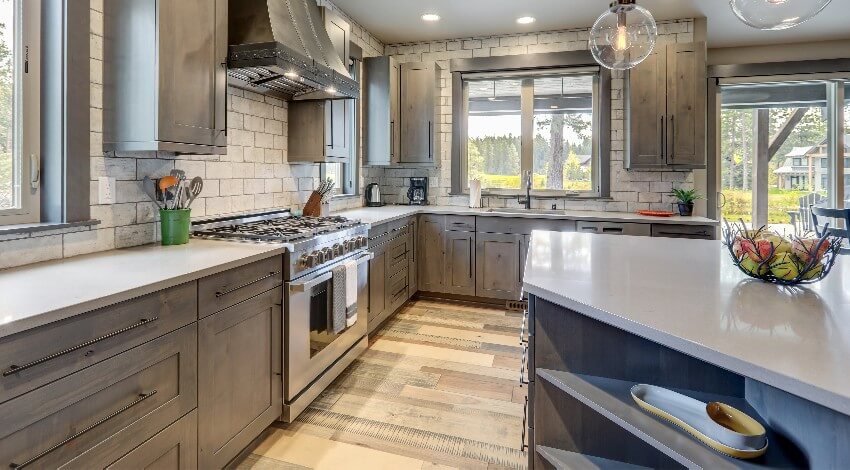
These cabinets are subjected to a great deal of wear and tear. Hence, your cabinet doors must be made to last as they constantly deal with several household members opening and closing them dozens of times per day. Laminate solutions provide you with the long-lasting quality you need.
Laminate doors are created by layering composite material on top of particleboard or medium-density fiberboard (MDF). Laminate, unlike wooden doors and cabinets, will not distort or degrade over time. It is also more stain-resistant. Each cabinet and door can survive for 30 years or more if properly maintained. Get more details about MDF cabinet doors here.
When designing or upgrading a culinary space, pure wood cabinets and doors are usually the most expensive option. Installing laminate cabinet doors helps cut expenses when undertaking upgrades on a limited budget. It is also a low-cost solution to replace your cabinet’s doors.
Wood leftovers and excess lumber are regularly used to make the base of these doors. As a result, these cabinet doors, like glass ones, are a more environmentally friendly alternative than real wood doors.
High-pressure laminate cabinet doors are available in almost any color you can imagine. Furthermore, some of the design choices appear to be made of actual wood. However, staining or sealing is not required to keep these products in good condition.
Those who want to live a more ecologically beneficial and sustainable lifestyle would welcome the option of laminated doors. This type of door does not require manufacturers to cut down trees or use materials to fabricate and deliver them.
Furthermore, you do not need to arrange complementary cabinets on top and bottom, as with any other design combination. These cabinets allow for greater versatility and innovation.
Numerous people opt for a streamlined design, with white cabinetry above and a dark color underneath. There are also a plethora of knobs and pulls to choose from.
However, due to the different ways these doors are constructed, the seams of the brown underlying particle board might be seen, which is sometimes described as a disadvantage of choosing laminates. It is not a major concern, though.
How to Choose Laminate for Cabinets
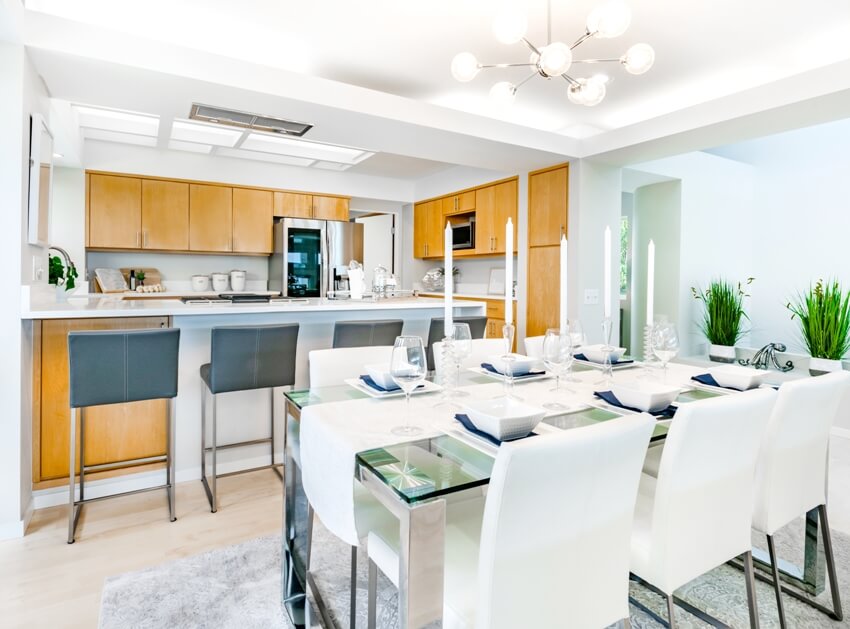
Select Laminate Colors Carefully
Keep in mind that the colors you choose will have a big impact on the entire look of your kitchen, so give it your best shot and make the perfect decision. For instance, that lovely red laminated cabinetry you noticed in your colleague’s huge home may make your compact space appear even smaller.
Decide on your color choice depending on the size of the culinary space, the quantity of natural light accessible, your cooking manner, and, of course, your personal preference.
Understand that while white and light colors make your culinary area appear larger, they are also more difficult to maintain clean. Furthermore, take into account that scratches are significantly more obvious on dark surfaces than on bright ones.
Select High-Pressure Laminates
High-pressure types are attached to the substrate under intense pressure and heat. They have a substantially longer lifespan than low-pressure laminates. This is particularly crucial in the cooking area, where all materials must be impervious to water and heat.
However, even when utilizing a high-pressure laminate, persistent exposure to water and high humidity is not recommended.
Antibacterial and Fire-Resistant Laminates
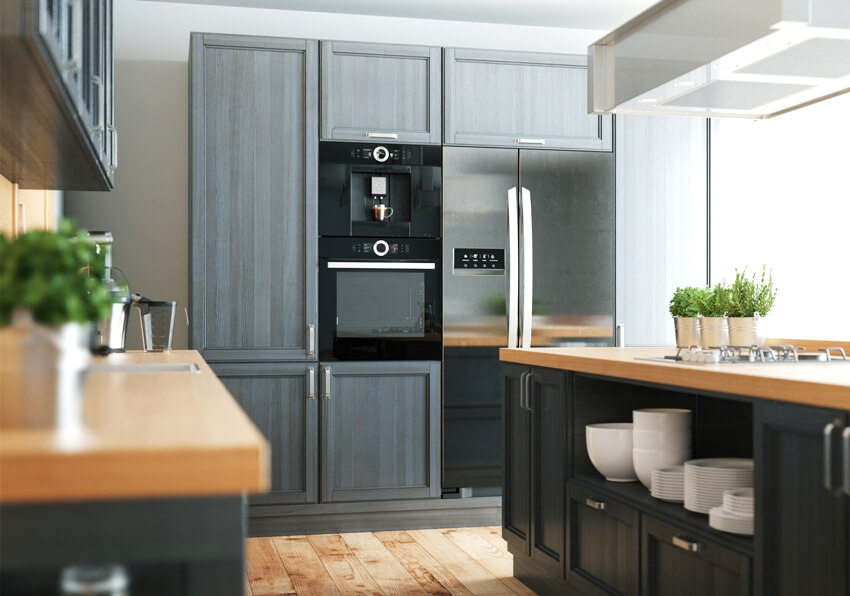
Ensure that the products you purchase have fire-resistant and antibacterial qualities to guarantee longevity and sanitation. Fire-resistant surfaces do not readily cause fires.
Aside from that, they are more resistant to heat and fumes. Antibacterial surfaces inhibit the development of pathogens and bacteria, which is a great benefit in any culinary space.
Laminate Edge Banding
Your cabinets will normally have an edge-banded finish, irrespective of the laminates you choose for your cabinet. Edge bands are narrow pieces of laminates that are intended to polish the uncovered sides of your shutters, giving them a sleek aesthetic while also increasing their structural sturdiness.
The edge band protects the shutters’ surfaces, shielding the underlying materials from dampness. The thickness and color of the edge banding is chosen to complement the width and color of the shutter.
Laminate Cabinet Cost
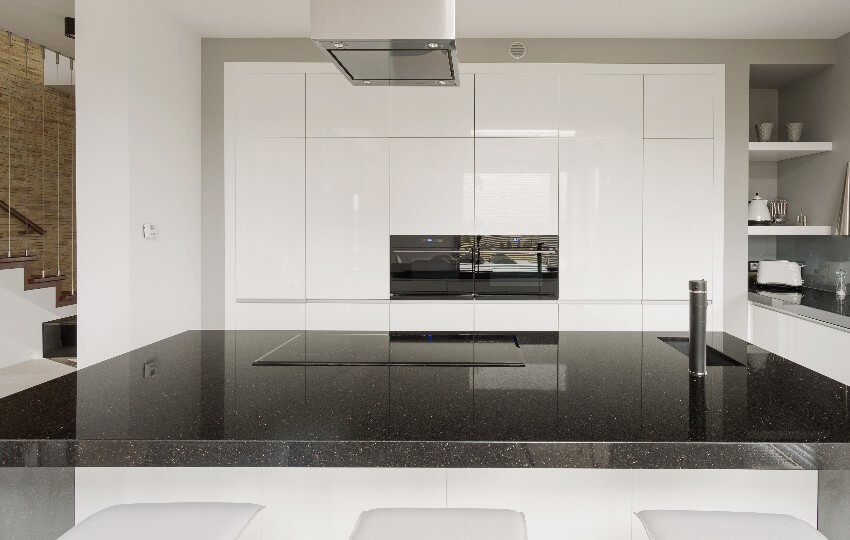
These cabinets are not made of real wood. They are created by pasting a photographic laminated sheet on top of an MDF (Medium Density Fiberboard) HDF (High-Density Fiber) layer.
The standard cost of these cabinets is around $5,000 to $8,000. Exceptionally superior ones might cost around $10,000 to $15,000.
On the lower end of the spectrum, these cabinets may be purchased for $4,000. It is nearly equivalent to wood veneers and is a less expensive alternative to wood. It is a synthetic material that is applied on particleboard using both high and low pressure.
How Much Does It Cost To Laminate Cabinetry?
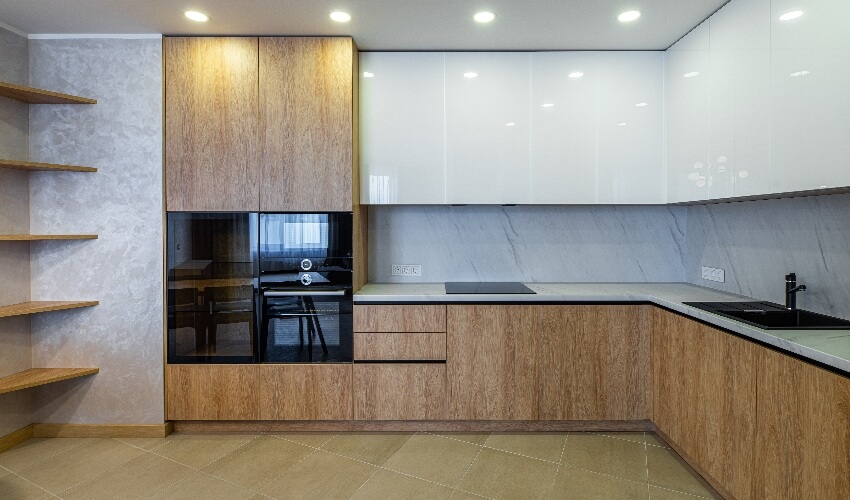
If you have your current wood cabinet, you can put a layer of laminated material it if you want. The cost of laminating a standard 10-foot-by-12-foot cabinet averages from $1,000 to $3,000.
Genuine wood veneer costs around $2,500 to $6,000 per square foot. A major project with a high-quality wooden veneer might cost $7,000 to $9,000 or more.
Laminating your existing cabinets might cost from around $1,000 to $14,000 or higher, contingent on the quality of the materials used and the size of your cabinet. Laminating is typically more affordable than replacing your cabinetry but more costly than refinishing.
How Long Does Laminate Cabinetry Last?
These cabinets have a lifespan of 30 to 50 years. High-pressure laminates are an excellent option for cabinets, but they can be costly.
Indeed, such cabinets are simpler to maintain than wooden surfaces and have a longer lifespan than real wood. They are susceptible to scratches, on the negative side.
You may believe that your old laminates are beyond replacement after decades of use, but fortunately, they can be refaced. These have to be taken, and the underneath wood will need to be cleaned and sanded smoothly.
Thus, expect a slightly increased cost owing to the added work. Yes, as long as these are not in utter deterioration, they can be refaced just like any other typical cabinet. Read more about our laminate kitchen cabinetry refacing guide for a related article.
How To Clean Laminate
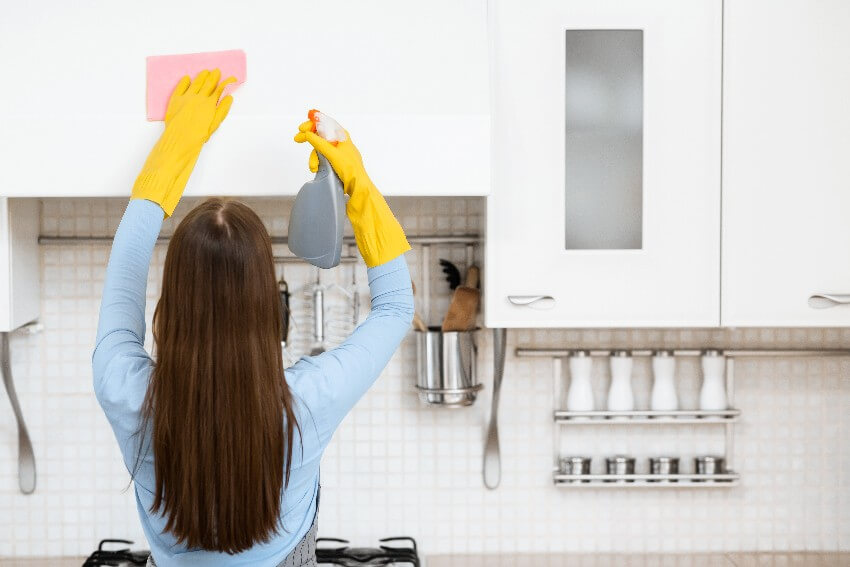
One of the most appealing aspects of this furniture is its ease of maintenance. Unlike wood, laminates do not quickly accumulate grease and fingerprints. It is also resistant to distortion and fading. You merely have to perform a few basic guidelines to keep your storage units and doors looking eye-pleasing:
• Weekly, clean the cabinet doors and surfaces with a normal duster or vacuum. Wipe them down with a delicate washcloth or a microfiber cleaning towel. Look for any grease or particles that can be wiped off the doors and corners.
• A combination of dishwashing soap and water is usually appropriate for thorough cleaning on occasion. Do not over-soak high-pressure laminates with water, and do not rub it too forcefully.
Wipe down the tough stains and other areas that require cleaning to eliminate stains or crumbs. You might also try spraying it with a mixture of water and white vinegar.
• If you need to treat a particularly difficult location, mix a smooth, light paste of water and baking soda. To eliminate the discoloration, carefully wipe this on the door. On your cabinet doors, do not use anything more aggressive than this mixture.
Take note, never use any harsh chemicals like bleach or any acid-based cleaning solutions (like muriatic acid), as these will gradually harm the surface.
How To Clean Grease Off Laminate
• If your unit has developed a layer of grease, you might have to clean it more thoroughly. Combine 1 cup of white vinegar and 2 cups of slightly heated water in a mixing bowl. Squeeze out a clean towel after soaking it in this solution for 3 to 5 minutes. Wipe the grease off your cupboards with this towel.
• If any greasy or muddy areas persist after wiping down your cabinet, pour a dab of pure white vinegar onto a towel and wipe out these areas once more. You may also blast those greasy and muddy spots with white vinegar using a spray bottle.
• Warm water should be used to rinse your cabinet, and a soft towel should be used to dry it. Fill a bowl or pail partially with warm and clean water. To remove any residual vinegar, soak a clean towel in water and wipe down your cabinets. Using a soft cloth, dry the surfaces.
Best Cleaner For Laminate
If you are only dealing with just a small amount of dust in your cabinet units, dusting it using a dry, soft cloth or vacuum should do the trick.
If your cabinets are constantly stained with food spills, a mild dishwashing soap, water, and a soft cloth would be enough to clean them properly.
However, if you are normally dealing with thick grime and grease, baking soda and vinegar would be the most ideal cleaner for your laminates. Even so, since vinegar is an acidic component, applying it persistently might eventually make the surface thinner.
Hence, we believe that the best and safest cleaner for laminates is mild dishwashing soap. You just have to look out for dish soap brands that promise to remove grease. Plus, you should apply it to your cabinet surface purely. Do not dilute it.
Can You Paint Laminate?
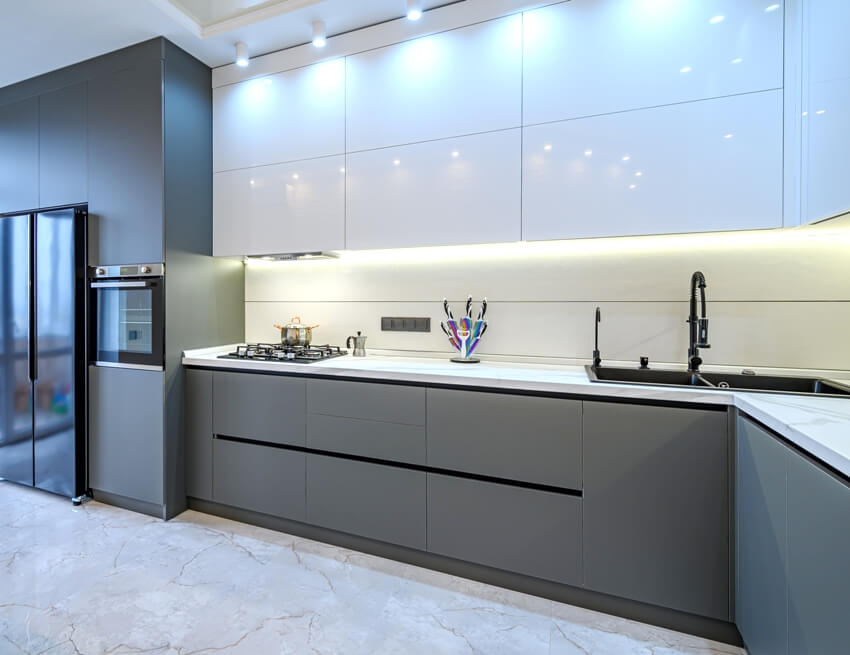
Yes, you can paint laminate cabinetry. However, since this surface is non-porous, it might be a bit more difficult for the paint to adhere properly. But here are some steps you can try to make sure that paint adheres to the furniture surface.
• Initially, check to see if the cabinet is still in great condition. Painting will not repair flaking or cracking. Afterward, thoroughly clean your cabinets.
These can hold a collection of greasy filth that prevents even the best type of paint from adhering. Simply spray it with a safe cleaning solution and wipe it down with a damp rag, making sure to get into all the nooks between surfaces.
• The next is a two-part process that includes a primer layer of chalky finish paint and one or two protective coatings of satin enamel paint.
• Keep your cabinet doors in place and apply your initial layer of chalky finish paint to the front of the cabinet doors. Next, using a gentle paintbrush, go into any areas that the roller cannot reach, such as the door inlays. Detach any knobs or pulls from your doors and store them in a container for later reattachment.
• Remove the doors and put them on their backsides to allow the paint to dry completely. Then, proceed to the cabinet frames and paint them in the same manner: roll the big flat surfaces and use the paintbrush to get into any tight spots or corners.
• Detach the cabinet hinges and continue adding chalk paint to the borders of the cabinet doors with a paintbrush.
• After all of the paint has dried, scrutinize it for uneven streaks, undesired brushwork, or other flaws in the layer of the chalk paint. You can smooth these down softly with sandpaper.
• Lastly, paint over everything with satin enamel paint in the same manner. It may take two coats to achieve a uniform and sleek finish. Then, roll and brush along the direction of the wood-like grain to avert paint buildup in the corner points.
How To Update Kitchen Cabinets Made From Laminate
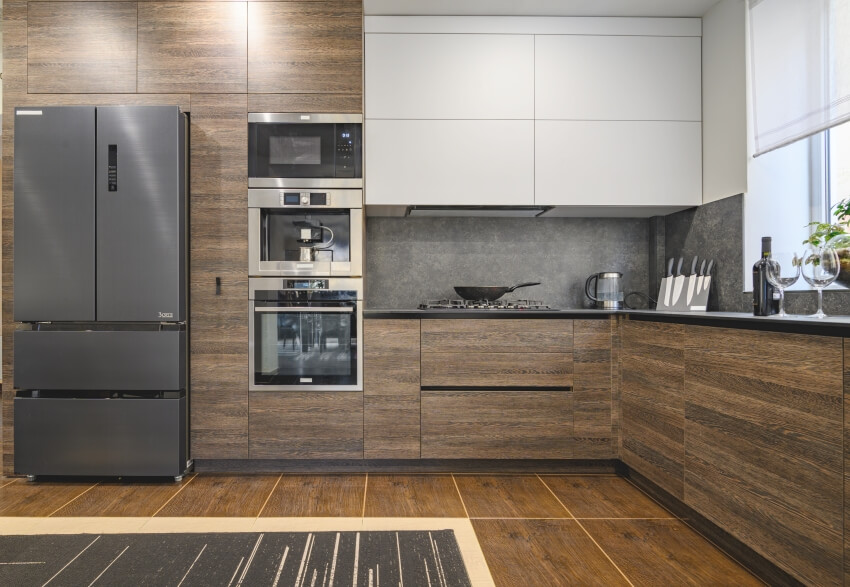
You can update your old storage spaces in 3 simple ways:
1. Painting. The simplest method to update the appearance of laminated storage furniture is to paint them. However, since the surface is slippery, you cannot just paint them as you would do with wood cabinets. Hence, if you want to do this updating method, read the previous section in this article under the subtitle, “Can You Paint Laminate Kitchen Cabinets?”.
2. Try replacing the cabinet doors. A cabinet builder can build new doors that perfectly suit your current cupboards by using your previous doors as a reference. Or, if you have wooden doors, repaint them or pick a complementary color for a stunning effect. You can also keep them in their original wood finish and let the laminates on the base offer a splash of color to the room.
3. Replace the cabinet hardware. It is indeed a smart idea to purchase some new hardware items and bring them home to install on a cabinet.
Is Laminate Good For Kitchen Cabinets?
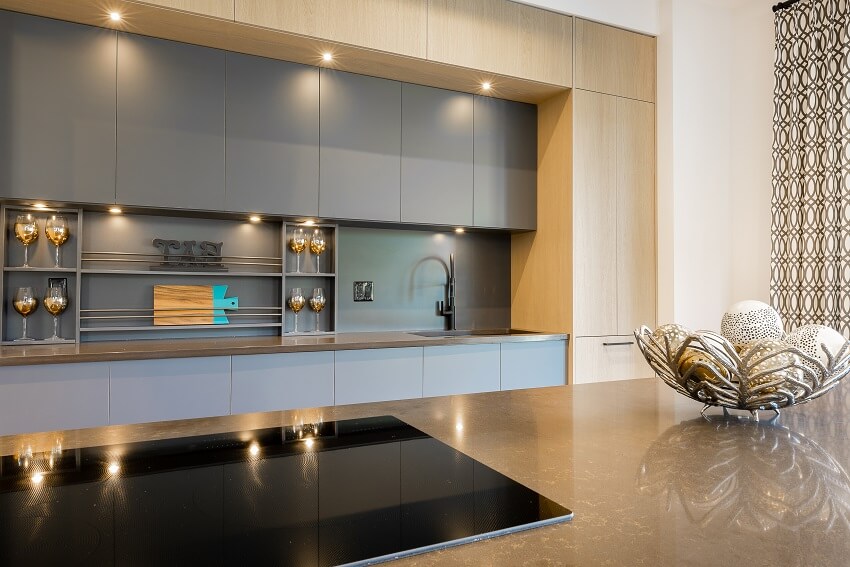
Yes. These cabinets have proven that they can be a better option than the ones made of wood. Laminates, especially the high-pressure ones, can be a really good choice for your cupboards as they can last for decades and are more affordable than hardwood varieties.
Visit our peel and stick laminate for cabinets guide for more related content.

